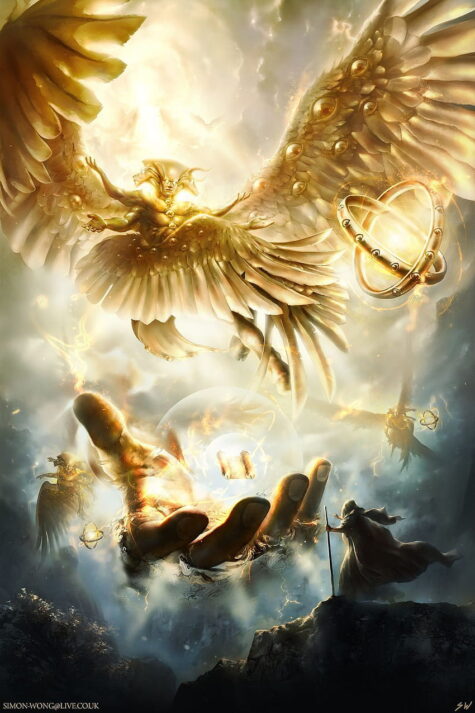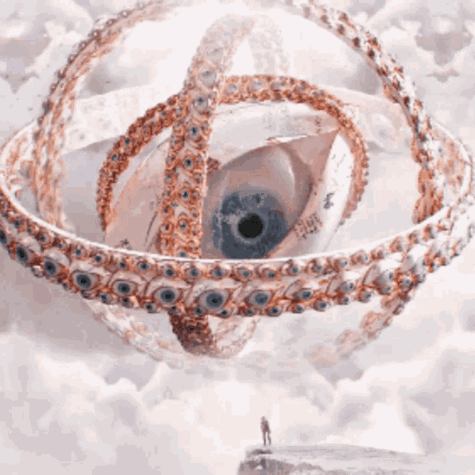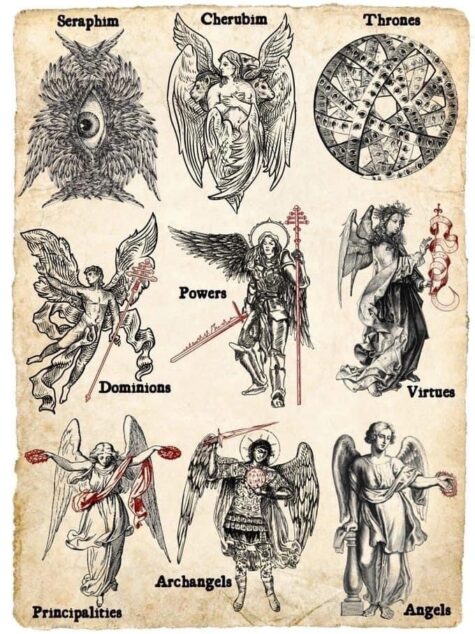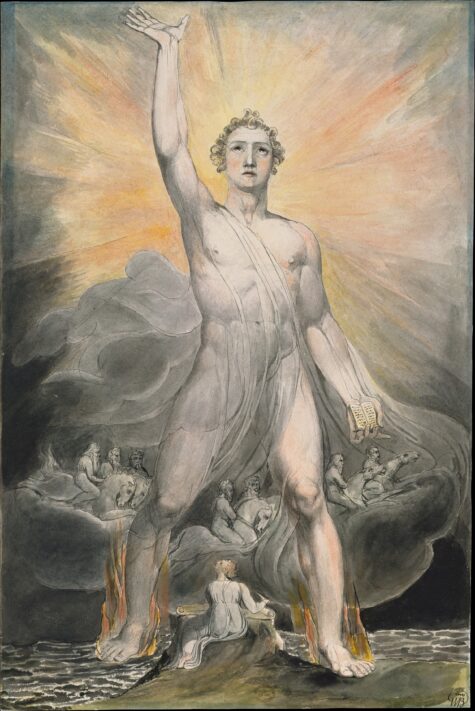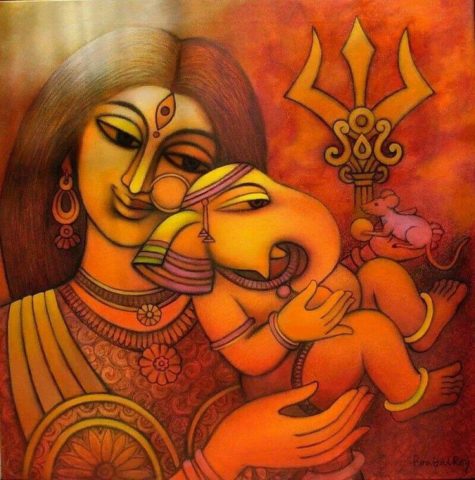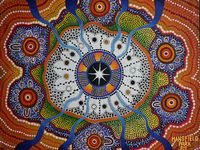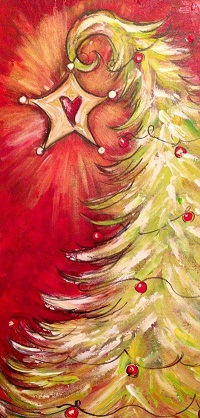Mythology
Biblical Angels – What do they look like?
When most people think of angels, a mental picture of a huge glowing human-like figure in white robes, massive white wings, and perhaps a halo, immediately comes to mind.
Some people even imagine angels like cherubim to look like little plump children with halos, tiny wings, and white loincloths, floating around on clouds with their harps.
This ideology was greatly influenced and it gained popularity from the depiction of angels in Christian art and media over the years.
However, it is inaccurate by biblical standards. Though the Bible doesn’t give a specific form for all angels, it does describe a few of them and this description is very different from what many people have imagined them to be.
You can note that the Bible consistently gives a bizarre description of angels when it comes to revealing the glory of heaven to men like John, Daniel, and Ezekiel.
But when it came to earthly errands, all the people who saw them, saw them in a form they could relate to.
Biblical Descriptions of Angels:
- Revelation 4:8 mentions four living creatures before God’s throne that had six wings and were covered with eyes all around, even under their wings.
- Ezekiel 1:16-18 Ezekiel describes creatures that are like “a wheel within a wheel with each of their four rims filled with eyes all around.” These particular angels serve as the wheels of God’s throne.
- Ezekiel 1:10 In Ezekiel’s vision of God, Cherubim are described as having four wings, 2 for covering their feet and 2 for flight and have 4 faces: human, lion, ox and an eagle Their name means ‘fulfillment of wisdom’.
- Isaiah 6:2 Seraphim are described in as having six wings; 2 to cover their feet, 2 for their flight, and 2 covering their face. They are attendants at God’s throne and praise Him forever. Their name translates to mean ‘the burning ones’.
- Daniel 8:15 On the other hand, some biblically accurate angels also appeared to men in the form of humans. Daniel describes the one who appeared to him as ‘having the form of a man.’
- Genesis 18:22 The three angels who appeared to Abraham also looked like human travelers and that was why he was hospitable to them. These same angels led Lot and his family out of the city of Sodom and Gomorrah.
- Luke 24:4 In the New Testament, the ones who were at Jesus’ tomb on the morning of His resurrection were described to have been ‘two men in dazzling clothes.’
- Acts 1:10 When Jesus ascended to heaven, it was recorded that there were two men with white cloth who addressed His disciples. Biblical scholars naturally assume them to be angels.
- Ephesians 1:21 Virtues are mainly associated with control over the elements. Their primary appearance is a beam of light.
Fear Not?
Just imagine one of the bizarre-looking angels around God’s throne appearing to a human to give them His message. The words ‘fear not’ wouldn’t do the slightest thing to quell their fears. They’d probably have a heart attack on the spot from fright or take off screaming their heads off.
Taking on a human-like figure helps people focus on the message, rather than the messenger.
Specific Angel Lore
- Seraphim:
One may trace the historical influences for the Seraphim from its name. Seraphim derives from the Hebrew word “Seraph,” which means “to burn” in English. Digging deeper, the Hebrew word “Saraph” means “venomous desert snake”. In ancient Egypt, people referred to the cobra as “the flaming one.” Its icon was called Uraeus, and it usually adorned the Pharoah’s headpiece.
Several historians speculate that the authors of the Old Testament derived Seraphim’s wings and flames from Egyptian imagery and associations with the cobra.
- Cherubim.
The Cherubim, later shortened to Cherub, is the lowest in rank among the four. The Bible describes these beings as animal-human hybrids, tasked with guarding the garden of Eden against humankind. The Devil was a Cherub.
The biblical description is far from how we imagine the Cherub now. While scholars credit its modern-day image to Greek and Roman deities like Cupid, they attribute the detail in the Bible to cultural exchanges with ancient Babylonia, Syria, and Egypt. The Cherub’s function of guarding sacred places and their mixed appearance is similar to that of the Babylonian Lamassu, Egyptian Sphynx, and Hittite Griffin.
- The Ophanim
The Ophanim, or “the wheels,” is arguably the most bizarre being in the Bible. Ezekiel’s account in the Bible describes them as beings made out of interlocking gold wheels with each wheel’s exterior covered with multiple eyes. They move by floating themselves in the sky. They are tasked with guarding God’s throne.
There is no exact historical origin for the Ophanim. Josef F. Blumrich, a former NASA employee, theorized that Ezekiel’s vision of the wheels and other angels might have been a UFO sighting. However, critics label him as a conspiracy theorist.
Nevertheless, other authors claim that an ingested psychedelic substance caused the prophet’s vision. Scholars have also proposed that the image was merely a metaphor for God’s mystery.
- The Virtues
According to The Etymologies of Isidore of Seville, the Virtues are known for their control of the elements. In addition to being the spirits of motion, they also assist in governing nature. They also assist with miracles, as well as encourage humans to strengthen their faith in God.
The term Angel comes from the Greek word Angelos, which originated from the Hebrew word for messenger, Mal’ akh. The Malakim are messengers of God and more closely resemble humans. Regarded as the foot soldiers of heaven, they act on God’s behalf as protectors and/or messengers.
However, while the Malakim looked like human beings, there was no mention of them having wings in the Bible.
The earliest known Christian image of an angel from the mid-third century was without wings. It wasn’t until the late fourth century that artists reimagined angels with the possession of wings. According to some researchers, this was done to represent their sublime nature, despite artists knowing that scripture did not describe them as having wings.
How Hou Yi Shot The Sun
In this ancient Chinese myth, the Sun was spared for our prosperity. Enjoy!
In ancient Chinese mythology, the sky had not one, but 10 suns. Every day, the solar goddess Shiho would pick up one of these suns (also her sons) and wheel him across the sky in her chariot. In the meantime, the other nine would play among the leaves of the mythical Fusang tree, believed to be more than 10,000 feet tall.
This system worked well until the day that the suns grew bored of their responsibility. They decided to run across the sky all at once, planning to generate enough light and heat so that they could all take a few days off. Instead, this solar scamper dried up rivers, scorched the Earth and led to widespread drought.
Taking pity on suffering mortals, the sun god Dijun called in the expert archer Hou Yi. With 10 magic arrows, the story goes that Hou Yi was to discipline the irresponsible suns. Hou Yi first tried to reason with the suns. When that didn’t work, he then pretended to shoot at them with his bow to intimidate them. When the suns again refused to heed Hou Yi’s warnings, he began to shoot at them one by one.
As each one fell, they turned into a 3 legged raven. Finally only one sun was left and King Yao as well as the sun’s mother asked for him to be spared for the prosperity of man.
Note: According to an alternative story, a young boy stole Hou Yi’s final arrow, thus saving Earth from perpetual darkness.
Sources:
How Ganesh Came Into Being
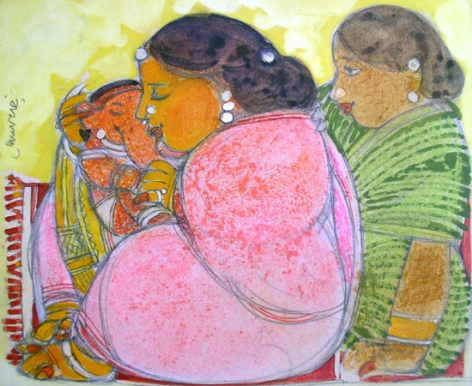
The legend behind the birth of Ganesha is as follows:
It is said that Goddess Parvati, before taking an elaborate bath, wanted someone to stand guard at the door.
Not finding anyone, she created the idol of a child from the sandalwood paste that she had applied on herself, and breathed life into it. She told the boy she had created not to let anyone in, and went to have her bath. When her husband, Lord Shiva came home, the child could not recognise him and refused to let him in. Shiva was furious, and severed the head of the child.
When she learnt that the child she had created was dead, Parvati was distraught and asked Shiva to revive him immediately. Shiva ordered his lieutenants to get the head of any creature that was sleeping with its head facing north. The servants returned with the head of an elephant. Shiva joined the elephant’s head to the boy’s body, and Parvati’s child lived again.
The legend also says that Shiva made the boy the leader of his armies. Hence, the name Ganesha, meaning ‘god of the army’.
Who is Ganesh?
Ganesha is India’s cutest god. He has the head of an elephant on which is perched a dainty tiara, four pudgy hands joined to a sizeable belly with each hand holding its own symbolic object. One has a trishul, or a trident, the second, an ankush, or goad made from his very own broken tooth, the third hand elegantly holds a lotus and the fourth a rosary (which is sometimes replaced by modaks – his favourite sweet). His appetite for sweets is legendary and offerings of them are often left at his shrine.
Ganesha is famous not only for being a trickster and for his sense of humour, but equally for his wisdom. He is the son of Shiva (Destroyer in the Hindu Holy Trinity of Creator-Preserver-Destroyer) and Parvati (Shiva’s consort).
The chubby, gentle, wise, elephant-headed Ganesh, or Ganesha, is one of Hinduisms most popular deities. He is the remover of obstacles, the deity whom worshippers first acknowledge when they visit a temple. He is also patron of letters and of learning; he is the legendary scribe who, using his broken tusk, which he often holds, wrote down parts of the Mahabharata epic.
From Loving Ganesa
by Satguru Sivaya Subramuniyaswami
Here’s a life changing action
Beginning today, treat everyone you meet as if they were going to be dead by midnight. Extend to them all the care, kindness and understanding you can muster, and do it with no thought of any reward. Your life will never be the same again.
~Og Mandino
This is an image of Kwan Yin. She is one of the most universally beloved of deities in the Buddhist tradition. She is the embodiment of compassionate loving kindness. As the Bodhisattva of Compassion, She hears the cries of all beings.
You can read a lovely story about her at Urban Dharma
- Radical Self Care Project Overview by shirleytwofeathers - No Comment
- Radical Self Care Image Gallery by shirleytwofeathers - No Comment
- It’s A Wrap by shirleytwofeathers - 3 Comments
- Something To Consider by shirleytwofeathers - 1 Comment
- Nurturing Your Precious Self by shirleytwofeathers - 3 Comments
me: Make Your Own Violet Fire
Abdulrahman: Money Chant – Very Fast
Shirley Twofeathers: It’s A Wrap
Daniel Knirs: It’s A Wrap
Shirley Twofeathers: It’s A Wrap
